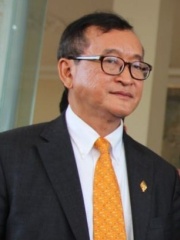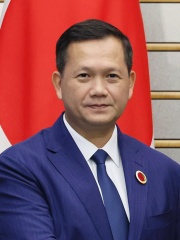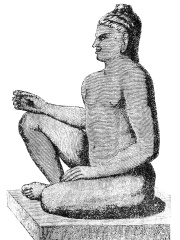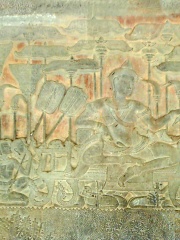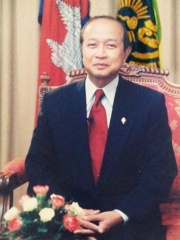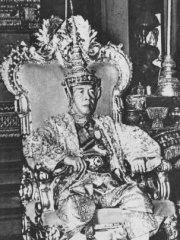
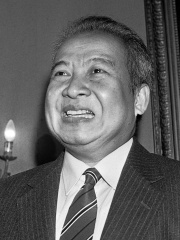
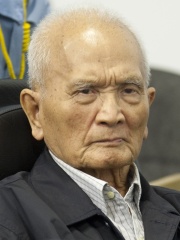
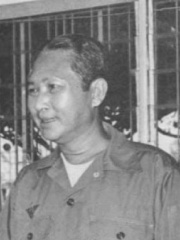
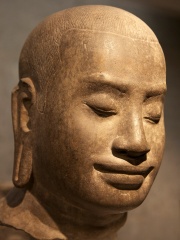
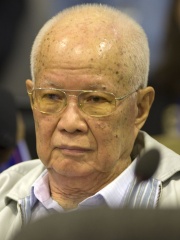
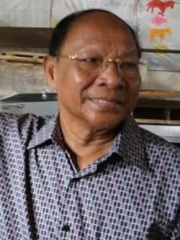

The Most Famous
POLITICIANS from Cambodia
This page contains a list of the greatest Cambodian Politicians. The pantheon dataset contains 19,576 Politicians, 28 of which were born in Cambodia. This makes Cambodia the birth place of the 93rd most number of Politicians behind Montenegro, and Nigeria.
Top 10
The following people are considered by Pantheon to be the top 10 most legendary Cambodian Politicians of all time. This list of famous Cambodian Politicians is sorted by HPI (Historical Popularity Index), a metric that aggregates information on a biography's online popularity. Visit the rankings page to view the entire list of Cambodian Politicians.

1. Pol Pot (1925 - 1998)
With an HPI of 82.87, Pol Pot is the most famous Cambodian Politician. His biography has been translated into 114 different languages on wikipedia.
Pol Pot (born Saloth Sâr; 19 May 1925 – 15 April 1998) was a Cambodian politician, revolutionary, and dictator who ruled the communist state of Democratic Kampuchea from 1975 until his overthrow in 1979. During his reign, his administration oversaw mass atrocities and he is widely believed to be one of the most brutal despots in modern world history. Ideologically a Maoist and Khmer ethnonationalist, Pot was a leader of Cambodia's Communist movement, known as the Khmer Rouge, from 1963 to 1997. He served as General Secretary of the Communist Party of Kampuchea from 1963 to 1981, during which Cambodia was converted into a one-party state. Between 1975 and 1979, the Khmer Rouge perpetrated the Cambodian genocide, in which an estimated 1.5–2 million people died—approximately one-quarter of the country's pre-genocide population. In December 1978, Vietnam invaded Cambodia to remove the Khmer Rouge from power. Within two weeks Vietnamese forces occupied most of the country, ending the genocide and establishing a new Cambodian government, with the Khmer Rouge restricted to the rural hinterlands in the western part of the country. Born to a prosperous farmer in Prek Sbauv, French Cambodia, Pol Pot was educated at some of Cambodia's most elite schools. Arriving in Paris in October 1949 on an academic scholarship, he later joined the French Communist Party in 1951 while studying at École française de radioélectricité. Returning to Cambodia in 1953, he involved himself in the Khmer Viet Minh organisation and its guerrilla war against King Norodom Sihanouk's newly independent government. Following the Khmer Viet Minh's 1954 retreat into North Vietnam, Pol Pot returned to Phnom Penh, working as a teacher while remaining a central member of Cambodia's Marxist–Leninist movement. In 1959, he helped formalise the movement into the Kampuchean Labour Party, which was later renamed the Communist Party of Kampuchea (CPK). To avoid state repression, in 1962 he relocated to a jungle encampment and in 1963 he became the CPK's leader. In 1968, he relaunched the war against Sihanouk's government. After Lon Nol ousted Sihanouk in a 1970 coup, Pol Pot's forces sided with the deposed leader against the new government, which was bolstered by the United States military. Aided by the Viet Cong militia and North Vietnamese troops, Khmer Rouge forces advanced and controlled all of Cambodia by 1975. Pol Pot transformed Cambodia into a one-party state that he called Democratic Kampuchea, seeking to create an agrarian socialist society that he believed would evolve into a communist one. Year Zero was an idea put into practice by Pol Pot where he believed that all cultures and traditions must be completely destroyed and a new revolutionary culture must replace it starting from scratch. "Year Zero" was announced by the Khmer Rouge on April 17, 1975, where everything before that date must be purged. The Khmer Rouge emptied the cities, frogmarched Cambodians to labor camps and relocated the urban population to collective farms, where mass executions, abuse, torture, malnutrition and disease were rampant. In the Killing Fields, more than 1.3 million people were executed and buried in mass graves. Pursuing complete egalitarianism, money, religion, and private property were abolished and all citizens were forced to wear the same black clothing. Repeated purges of the CPK generated growing discontent; by 1978, Cambodian soldiers were mounting a rebellion in the east. After several years of Khmer Rouge incursions and massacres on Vietnamese territory, Vietnam invaded Cambodia in December 1978. By January 1979, Pot and the Khmer Rouge had been toppled. The surviving Khmer Rouge members retreated to the scattered jungles near the Thai border, from where they continued to fight and raid. Severely weakened, they were hunted down by Vietnamese soldiers until their withdrawal in 1989. In declining health, Pol Pot stepped back from many of his roles in the movement. In 1998, the Khmer Rouge commander Ta Mok placed Pot under house arrest. Pol Pot died shortly afterward. During his rise to power which occurred at the high point of the communist movement's potency across the world, Pot proved to be divisive to the international communist movement. Many claimed that he deviated from orthodox Marxism–Leninism, but China supported his government as a bulwark against Soviet influence in Southeast Asia. Regarded as a totalitarian dictator guilty of crimes against humanity, he has been widely denounced internationally for his role in the Cambodian genocide.

2. Norodom Sihanouk (1922 - 2012)
With an HPI of 77.77, Norodom Sihanouk is the 2nd most famous Cambodian Politician. His biography has been translated into 79 different languages.
Norodom Sihanouk (; 31 October 1922 – 15 October 2012) was a member of the House of Norodom who led Cambodia as King, Chief of State and Prime Minister. He is known as Samdech Euv (meaning "King Father"). During his lifetime, Cambodia was under various regimes, from French colonial rule (until 1953), a Japanese puppet state (1945), an independent kingdom (1953–1970), a military republic (1970–1975), the Khmer Rouge regime (1975–1979), a Vietnamese-backed communist regime (1979–1989), a transitional communist regime (1989–1993) to eventually another kingdom (since 1993). Sihanouk was the only child of Prince Norodom Suramarit and Princess Sisowath Kossamak, daughter of King Sisowath Monivong. When his grandfather Monivong died in 1941, Sihanouk became king amidst French colonial rule. After the Japanese occupation of Cambodia during World War II, he secured Cambodian independence from France in 1953. He abdicated in 1955 and was succeeded by his father, Suramarit, so as to directly participate in politics. Sihanouk's political organization Sangkum won the general elections that year, and he became prime minister of Cambodia. He governed the country under one-party rule and suppressed political dissent. After his father died in 1960, Sihanouk assumed a new position as Chief of State of Cambodia. Officially neutral in foreign relations, Sihanouk was closer to the communist bloc in practice. The 1970 Cambodian coup d'état ousted him, and he fled to China and North Korea, forming a government-in-exile and a resistance movement there. He encouraged Cambodians to fight the new government and backed the Khmer Rouge during the Cambodian Civil War. He returned as figurehead head of state after the Khmer Rouge's victory in 1975. His relations with the new Khmer Rouge government soured, and in 1976 he resigned. He was placed under house arrest until Vietnamese forces overthrew the Khmer Rouge in 1979. Sihanouk went into exile again and in 1981 formed FUNCINPEC, a resistance party. The following year, he became president of the Coalition Government of Democratic Kampuchea (CGDK), a broad coalition of anti-Vietnamese resistance factions which retained Cambodia's seat at the United Nations, making him Cambodia's internationally recognized head of state. In the late 1980s, informal talks were carried out to end hostilities between the Vietnam-supported People's Republic of Kampuchea and the CGDK. In 1990, the Supreme National Council of Cambodia was formed as a transitional body to oversee Cambodia's sovereign matters, with Sihanouk as its president. The 1991 Paris Peace Accords were signed, and the UN Transitional Authority in Cambodia (UNTAC) was established the following year. The UNTAC organized the general elections in 1993, and a coalition government, jointly led by his son Norodom Ranariddh and Hun Sen, was subsequently formed. Sihanouk was reinstated as Cambodia's king. He abdicated again in 2004, and the Royal Council of the Throne chose his son Norodom Sihamoni as his successor. Sihanouk died in Beijing in 2012. Between 1941 and 2006, Sihanouk produced and directed 50 films, some of which he acted in. The films, later described as being of low quality, often featured nationalistic elements, as did a number of the songs he wrote. Some of his songs were about his wife Monique, the nations neighboring Cambodia, and the communist leaders who supported him in his exile. In the 1980s, Sihanouk held concerts for diplomats in New York City. He also participated in concerts at his palace during his second reign. Sihanouk is remembered for his role in shaping modern Cambodia, particularly in leading the country to independence, although his reputation was damaged by his association with the Khmer Rouge in the 1970s.

3. Nuon Chea (1926 - 2019)
With an HPI of 74.45, Nuon Chea is the 3rd most famous Cambodian Politician. His biography has been translated into 34 different languages.
Nuon Chea (Khmer: នួន ជា; born Lao Kim Lorn; 7 July 1926 – 4 August 2019), also known as Long Bunruot (Khmer: ឡុង ប៊ុនរត្ន) or Rungloet Laodi (រុងឡឺត ឡាវឌី Thai: รุ่งเลิศ เหล่าดี), was a Cambodian politician and revolutionary who was the chief ideologist of the Khmer Rouge. He also briefly served as acting Prime Minister of Democratic Kampuchea. He was commonly known as "Brother Number Two" (Khmer: បងធំទី២), as he was second-in-command to Khmer Rouge leader Pol Pot, General Secretary of the Party, during the Cambodian genocide of 1975–1979. In 2014, Nuon Chea received a life sentence for crimes against humanity, alongside another top-tier Khmer Rouge leader, Khieu Samphan, and a further trial convicted him of genocide in 2018. These life sentences were merged into a single life sentence by the Trial Chamber on 16 November 2018. He died while serving his sentence in 2019.

4. Lon Nol (1913 - 1985)
With an HPI of 71.82, Lon Nol is the 4th most famous Cambodian Politician. His biography has been translated into 40 different languages.
Lon Nol (Khmer: លន់ នល់, also លន់ ណុល; 13 November 1913 – 17 November 1985) was a Cambodian military officer and politician who served as Prime Minister of Cambodia twice (1966–1967; 1969–1971), as well as serving repeatedly as defence minister and provincial governor. As a right-wing nationalist, he led the military coup of 1970 against Prince Norodom Sihanouk, abolished the monarchy, and established the short-lived Khmer Republic. Constitutionally a semi-presidential republic, Cambodia was de facto governed under a military dictatorship. He was the commander-in-chief of the Khmer National Armed Forces during the Cambodian Civil War and became President of the Khmer Republic on 10 March 1972. On 1 April 1975, as the only president of the republic 16 days before Angkar and the Khmer Rouge captured Phnom Penh, Lon Nol fled to Indonesia and later the United States, first to Hawaii and then to California, where he remained until his death in 1985.
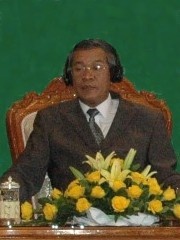
5. Hun Sen (b. 1952)
With an HPI of 71.38, Hun Sen is the 5th most famous Cambodian Politician. His biography has been translated into 62 different languages.
Hun Sen (born 5 August 1952) is a Cambodian politician and former military officer who currently serves as the president of the Senate. He previously served as the prime minister of Cambodia (1985–1993), the second prime minister (1993–1998) and the prime minister again (1998–2023). Hun Sen is the longest-serving head of government in Cambodia's history. He is the president of the Cambodian People's Party (CPP), originally known as the Kampuchean People's Revolutionary Party (KPRP), which has governed Cambodia since 1979, and has served as a member of the Senate since 2024. Born Hun Bunal, he changed his name to Hun Sen in 1972, two years after joining the Khmer Rouge as a soldier. He fought for the Khmer Rouge in the Cambodian Civil War and was a battalion commander in Democratic Kampuchea until defecting in 1977 and fighting alongside Vietnamese forces in the Cambodian–Vietnamese War. From 1979 to 1986 and again from 1987 to 1990, he served as Cambodia's foreign minister in the puppet government installed by Vietnam. At age 26, he was also the world's youngest foreign minister. Hun Sen rose to the premiership in January 1985 when the one-party National Assembly appointed him to succeed Chan Sy, who had died in office in December 1984. He held the position until the 1993 UN-backed elections which resulted in a hung parliament, with opposition party FUNCINPEC winning the majority of votes. Hun Sen refused to accept the result. After negotiations with FUNCINPEC, Norodom Ranariddh and Hun Sen agreed to simultaneously serve as First and Second Prime Minister, until the coalition broke down and Sen orchestrated a coup d'état in 1997 which toppled Ranariddh. Between 1998 and 2023, Hun Sen led the CPP to consecutive and often contentious election victories, overseeing rapid economic growth and development, but also corruption, deforestation and human rights violations. In 2013, Hun Sen and the CPP were reelected with a significantly reduced majority amidst a resurgent opposition. Allegations of voter fraud and irregularities led to unprecedented anti-government protests. In 2018, he was elected to a sixth and final term in a largely unopposed poll after the Supreme Court dissolved the main opposition party, with the CPP winning every seat in the National Assembly. He led the country during the onset of the COVID-19 pandemic and Cambodia's third chairmanship of ASEAN; and, after the 2023 election formally announced his resignation as prime minister in favour of his son, Hun Manet. He remains as party leader and in 2024, was appointed president of the Senate, ensuring his continued influence over the country's politics. Hun Sen has been prominent in communist, Marxist–Leninist, and now state capitalist and national conservative political parties, and although Khmer nationalism has been a consistent trait of all of them, he is thought to lack a core political ideology. He has been described as a "wily operator who destroys his political opponents" by The Sydney Morning Herald and as a dictator who has assumed highly centralized power in Cambodia and considerable personal wealth using violence and corruption, including a personal guard said to rival the country's regular army.

6. Jayavarman VII (1125 - 1218)
With an HPI of 71.15, Jayavarman VII is the 6th most famous Cambodian Politician. His biography has been translated into 34 different languages.
Jayavarman VII (Khmer: ព្រះបាទជ័យវរ្ម័នទី៧, lit. 'victory armor'), known posthumously as Mahaparamasaugata (1122–1218), was king of the Khmer Empire. He was the son of King Dharanindravarman II (r. 1150–1160) and Queen Sri Jayarajacudamani. He was the first Khmer king devoted to Buddhism; only one other had been a Buddhist. He built the Bayon as a monument to Buddhism. Historians generally consider Jayavarman VII the most powerful of the Khmer monarchs. His government built many projects, including hospitals, highways, rest houses, and temples. With Buddhism as his motivation, Jayavarman VII is credited with introducing a welfare state that served the Khmer people's physical and spiritual needs.

7. Khieu Samphan (b. 1931)
With an HPI of 70.43, Khieu Samphan is the 7th most famous Cambodian Politician. His biography has been translated into 33 different languages.
Khieu Samphan (Khmer: ខៀវ សំផន; born 27 July 1931) is a Cambodian former politician, economist, and revolutionary who was Chairman of the State Presidium of Democratic Kampuchea from 1976 until 1979. As such, he served as Cambodia's head of state and was one of the most powerful officials in the Khmer Rouge movement, although Pol Pot remained the General Secretary of the Communist Party of Kampuchea. On 7 August 2014, along with other members of the regime, he was convicted and received a life sentence for crimes against humanity during the Cambodian genocide, and a further trial found him guilty of genocide in 2018. Prior to joining the Khmer Rouge, he was a member of Norodom Sihanouk's Sangkum government. After the 1967 leftist rebellion, Sihanouk ordered the arrest of leftists including Samphan, who fled into hiding until the Khmer Rouge takeover in 1975. Samphan succeeded Pol Pot as leader of the Khmer Rouge in 1985, and served in this position until 1998. Samphan is the oldest living former prime minister and the last surviving senior member of the Khmer Rouge following the deaths of Nuon Chea in August 2019 and Kang Kek Iew in September 2020.

8. Heng Samrin (b. 1934)
With an HPI of 67.21, Heng Samrin is the 8th most famous Cambodian Politician. His biography has been translated into 28 different languages.
Heng Samrin (Khmer: ហេង សំរិន; born 25 May 1934) is a Cambodian politician who served as the President of the National Assembly of Cambodia (2006–2023). Between 1979 and 1992, he was the de facto leader of the Hanoi-backed People's Republic of Kampuchea (1979–1989) and State of Cambodia (1989–1992) and General Secretary of the Kampuchean People's Revolutionary Party (1981–1991). He has been a member of Parliament since 14 June 1993. He is the oldest member of parliament, and the longest-serving president of the National Assembly in history. His honorary title is "Samdech Akka Moha Ponhea Chakrei Heng Samrin" (Khmer: សម្តេចអគ្គមហាពញាចក្រី ហេង សំរិន).

9. Norodom of Cambodia (1834 - 1904)
With an HPI of 67.01, Norodom of Cambodia is the 9th most famous Cambodian Politician. His biography has been translated into 27 different languages.
Norodom (Khmer: ព្រះនរោត្តម, Nôroŭttâm [nɔˈroːɗɑm]; born Ang Voddey (Khmer: អង្គវតី, Ângk Vôtei [ʔɑŋ ʋɔˈtəj]); 3 February 1834 – 24 April 1904) was King of Cambodia from 19 October 1860 until his death in 1904. He was the eldest son of King Ang Duong and was a half-brother of Si Votha and King Sisowath. He was elected to the throne in 1860 but would not be crowned until 1864 because Siam held the royal regalia (the royal crown and other artifacts). In 1863, he signed a treaty with France by giving France control over Cambodia's foreign relations in exchange for personal protection against his enemies. The treaty saved Cambodian independence, but French control over Cambodia's internal affairs strengthened continually until the end of his reign (full independence was not restored until 1953). His reign of 43 years and 188 days is the longest in Cambodian history in terms of verifiable exact date. Upon his death, he was succeeded by his half-brother, Sisowath. He is the progenitor of the House of Norodom which has been the ruling royal house of Cambodia since 1860.
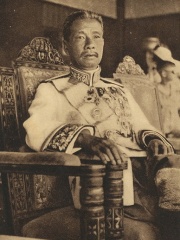
10. Sisowath Monivong (1875 - 1941)
With an HPI of 66.96, Sisowath Monivong is the 10th most famous Cambodian Politician. His biography has been translated into 28 different languages.
Sisowath Monivong (Khmer: ស៊ីសុវត្ថិ មុនីវង្ស, Sisŏvôtthĕ Mŭnivôngs [ˈsiːsoʋat muˈniːʋɔŋ]; 27 December 1875 – 23 April 1941) was the King of Cambodia from 9 August 1927 until his death in 1941. During his reign, Cambodia was a French protectorate. Monivong was the grandson of the poet-king Ang Duong, grandfather of Norodom Sihanouk and the great-grandfather of the current king, Norodom Sihamoni. His full regnal title and style was Preah Bat Samdech Preah Serey Monivarman Krom Luang Chao Chakrabangsa Sisowath Monivong Ney Preah Reacheanachak Kampuchea (Khmer: ព្រះបាទសម្តេចព្រះសិរីមុនីវរ្ម័នក្រុមហ្លួងចៅចក្របាងស្ស ស៊ីសុវត្ថិ មុនីវង្ស នៃព្រះរាជាណចក្រកម្ពុជា) which can be literally translated from Khmerized Sanskrit as "His majesty, glorious lord scholar-protector; His highness, lord of land and sea, Sisowath Monivong of the Kingdom of Kampuchea". He is the most recent male monarch from the House of Sisowath, as all his successors are members of the House of Norodom.
People
Pantheon has 28 people classified as Cambodian politicians born between 800 and 1977. Of these 28, 5 (17.86%) of them are still alive today. The most famous living Cambodian politicians include Hun Sen, Khieu Samphan, and Heng Samrin. The most famous deceased Cambodian politicians include Pol Pot, Norodom Sihanouk, and Nuon Chea.
Living Cambodian Politicians
Go to all RankingsHun Sen
1952 - Present
HPI: 71.38
Khieu Samphan
1931 - Present
HPI: 70.43
Heng Samrin
1934 - Present
HPI: 67.21
Sam Rainsy
1949 - Present
HPI: 57.98
Hun Manet
1977 - Present
HPI: 57.82
Deceased Cambodian Politicians
Go to all RankingsPol Pot
1925 - 1998
HPI: 82.87
Norodom Sihanouk
1922 - 2012
HPI: 77.77
Nuon Chea
1926 - 2019
HPI: 74.45
Lon Nol
1913 - 1985
HPI: 71.82
Jayavarman VII
1125 - 1218
HPI: 71.15
Norodom of Cambodia
1834 - 1904
HPI: 67.01
Sisowath Monivong
1875 - 1941
HPI: 66.96
Jayavarman II
800 - 835
HPI: 66.93
Yasovarman I
900 - 910
HPI: 66.79
Suryavarman II
1095 - 1150
HPI: 66.57
Norodom Ranariddh
1944 - 2021
HPI: 65.77
Norodom Suramarit
1896 - 1960
HPI: 65.62
Overlapping Lives
Which Politicians were alive at the same time? This visualization shows the lifespans of the 17 most globally memorable Politicians since 1700.

